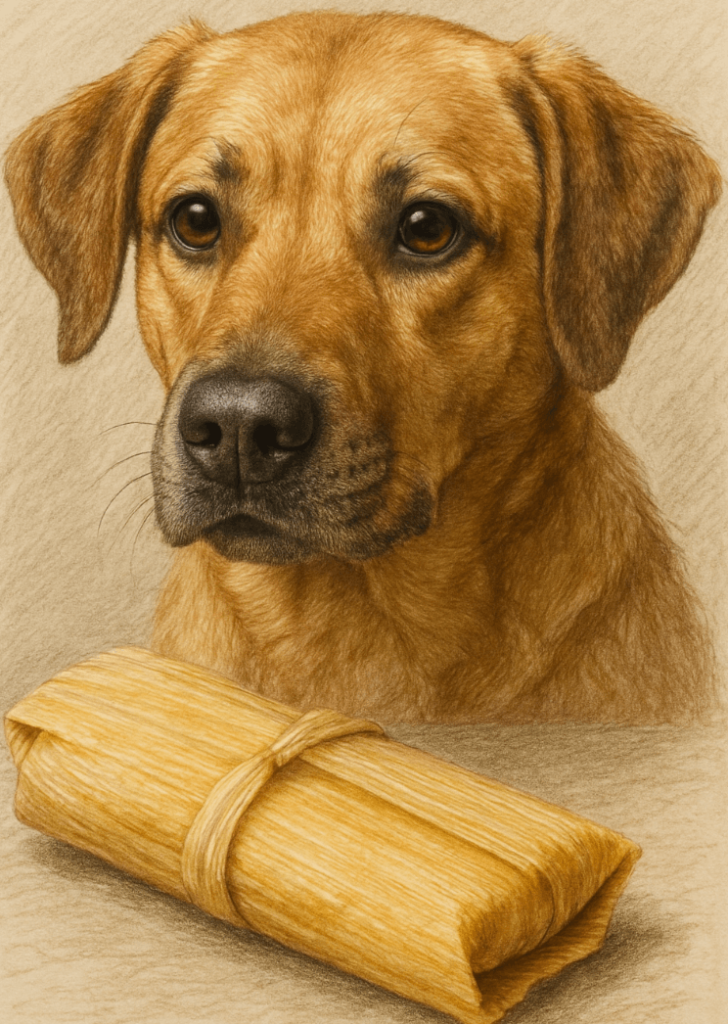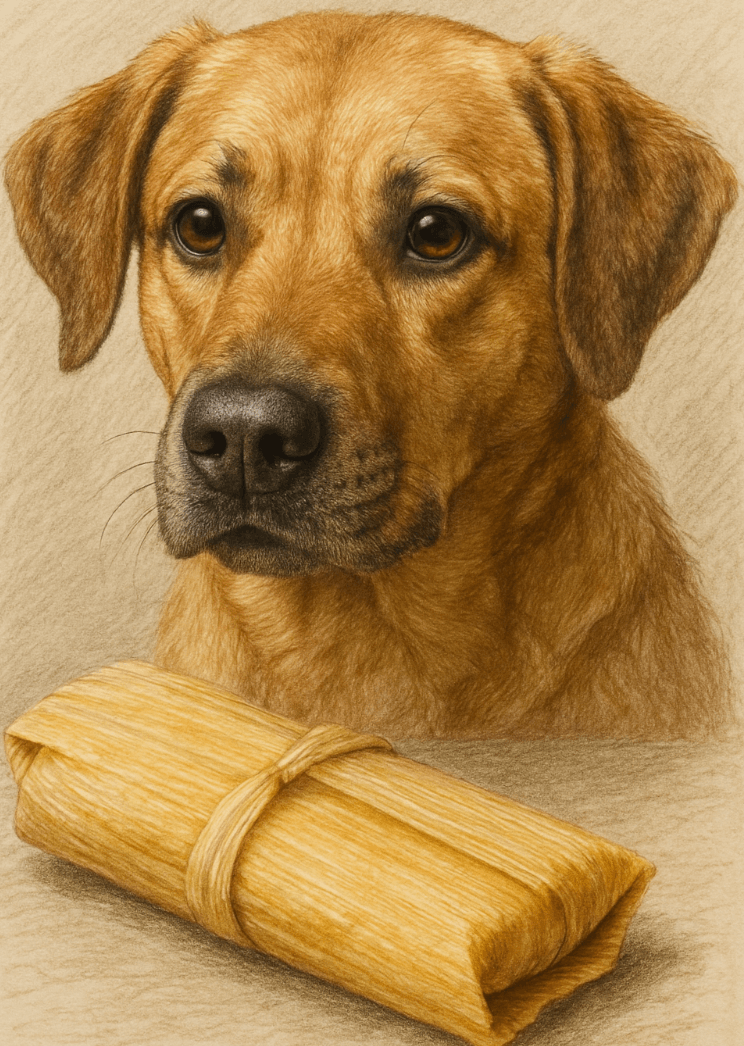Can Dogs Eat Tamales? What You Need to Know
Tamales are a delicious and traditional dish enjoyed by many, especially during holidays and family gatherings. But what happens when your furry friend gives you those irresistible puppy eyes while you’re enjoying this savory treat? Can dogs eat tamales safely, or should they be avoided altogether? While tamales may seem harmless, certain ingredients and preparation methods can pose risks to your dog’s health. In this blog post, we’ll explore the potential dangers, safe alternatives, and expert tips to ensure your pup stays happy and healthy while you indulge in your favorite foods.
Potential Risks of Feeding Tamales to Dogs
While tamales may look like a tempting treat for your dog, they contain several ingredients that can be harmful. Understanding these risks is crucial before sharing any part of this dish with your pet.
High Fat Content:
Tamales are often made with lard or oil, which can upset your dog’s stomach and lead to pancreatitis if consumed in large amounts.Onions and Garlic:
Many tamale recipes include onions and garlic, both of which are toxic to dogs and can damage their red blood cells.Spices and Seasonings:
Spices like chili powder or cumin can irritate your dog’s digestive system and cause discomfort or vomiting.Corn Husks and Wrappers:
Corn husks used to wrap tamales are not digestible and can cause choking or intestinal blockages if ingested.Added Salt and Sugar:
Excessive salt and sugar levels in tamales can lead to dehydration, obesity, or other health issues in dogs.
These risks highlight why caution is essential when considering feeding tamales to your dog. Always prioritize their safety over curiosity.
Safe Ingredients in Tamales for Dogs (If Prepared Properly)
Not all components of tamales are harmful to dogs. With careful preparation, some ingredients can be shared in moderation as an occasional treat.
Plain Corn Masa:
The corn-based dough used in tamales is generally safe for dogs if it’s plain and free of added fats, spices, or seasonings.Lean Proteins:
If the filling includes plain, cooked chicken or turkey without seasoning, it can be a safe and healthy option for your pup.Vegetables Like Pumpkin or Carrots:
Some tamale recipes include vegetables like pumpkin or carrots, which are nutritious and beneficial for dogs’ digestion.Cheese (In Small Amounts):
Plain, low-fat cheese used as a filling can be given sparingly, though it’s best avoided for lactose-intolerant dogs.No Harmful Additives:
Ensure that any tamale ingredients shared with your dog are free of onions, garlic, salt, and other harmful additives.
By carefully selecting and preparing tamale ingredients, you can offer your dog a safe and tasty snack without compromising their health.
Check this guide 👉Can Dogs Eat Cotton Candy? Best 7 Expert Tips!
Check this guide 👉Can Dogs Eat Couscous? Best 7 Expert Tips!
Check this guide 👉Can Dogs Eat Nopales? Best 7 Expert Tips!

Safe Tamale Ingredients for Dogs | Harmful Tamale Ingredients for Dogs |
|---|---|
Plain corn masa | Onions and garlic |
Lean, unseasoned chicken or turkey | Spices like chili powder or cumin |
Plain pumpkin or carrots | High-fat lard or oil |
Low-fat cheese (in moderation) | Corn husks or wrappers |
Plain, unsalted broth | Excessive salt or sugar |
How to Safely Share Tamales with Your Dog
If you decide to share tamales with your dog, it’s important to take precautions to minimize risks. Follow these guidelines to ensure a safe experience.
Prepare Homemade Tamales:
Make a small batch of plain tamales using dog-safe ingredients, avoiding spices, oils, and harmful additives.Remove Corn Husks Completely:
Never allow your dog to chew on or ingest the corn husks, as they can cause choking or digestive blockages.Serve in Moderation:
Even safe ingredients should only be given in small portions to avoid upsetting your dog’s stomach.Avoid Store-Bought Tamales:
Commercially prepared tamales often contain high levels of fat, salt, and spices, making them unsuitable for dogs.Monitor for Reactions:
After offering a small piece, watch for signs of digestive upset, such as vomiting or diarrhea, and consult your vet if needed.
By following these steps, you can safely incorporate tamale-inspired treats into your dog’s diet.
Signs Your Dog May Have Eaten Harmful Tamales
Even with precautions, accidents can happen. If your dog sneaks a bite of tamale containing harmful ingredients, watch for these warning signs.
Vomiting or Diarrhea:
These symptoms may indicate gastrointestinal distress caused by fatty or spicy ingredients.Lethargy or Weakness:
Onions and garlic toxicity can lead to lethargy, weakness, or difficulty breathing due to anemia.Excessive Drooling:
Drooling can signal nausea or irritation from spices or seasonings in the tamale.Loss of Appetite:
If your dog refuses to eat after consuming tamales, it could be a sign of digestive upset or poisoning.Abdominal Pain or Swelling:
Signs of bloating or discomfort may indicate pancreatitis or an intestinal blockage from corn husks.
Recognizing these signs early allows you to seek veterinary care promptly, preventing further complications.
Common Mistakes to Avoid When Sharing Tamales with Dogs
Feeding tamales to your dog requires careful consideration to avoid mistakes that could endanger their health. Here are some pitfalls to watch out for.
Offering Store-Bought Tamales:
Pre-made tamales often contain high levels of fat, salt, and spices, making them unsafe for dogs.Ignoring Ingredient Labels:
Failing to check for harmful additives like onions, garlic, or excessive salt can lead to serious health issues.Leaving Corn Husks Accessible:
Corn husks are a choking hazard and should always be removed and disposed of properly.Overfeeding Treats:
Even safe ingredients can upset your dog’s stomach if given in large quantities. Stick to small portions.Assuming All Dogs React the Same Way:
Every dog is unique—what’s safe for one may not be safe for another, so always proceed with caution.
Avoiding these mistakes ensures a safer and healthier experience for your dog.
Alternatives to Tamales for Dogs
If you’re looking for festive treats to share with your dog, there are plenty of alternatives that mimic the flavors of tamales without the risks.
Homemade Dog-Safe Masa Cakes:
Prepare plain corn masa cakes baked with dog-safe ingredients like lean chicken or pumpkin.Turkey or Chicken Rolls:
Roll up plain, cooked turkey or chicken with mashed pumpkin for a tamale-inspired snack.Frozen Veggie Pops:
Blend plain pumpkin or carrots with water and freeze them into popsicles for a refreshing treat.Grain-Free Dog Treats:
Look for grain-free dog treats that use similar flavors, like chicken and sweet potato.DIY Meatballs:
Make mini meatballs using lean ground turkey, rice, and dog-safe vegetables for a fun alternative.
These alternatives allow you to celebrate with your dog while keeping them safe and satisfied.
Understanding Your Dog’s Nutritional Needs During Holidays
During holidays and celebrations, it’s easy to overlook your dog’s nutritional needs amidst all the excitement. Understanding their dietary requirements helps prevent overindulgence and health issues.
Stick to Their Regular Diet:
Holiday foods should only make up a small portion of your dog’s diet; their regular food should remain the staple.Watch for Food Stealing:
Dogs are opportunistic eaters and may sneak bites of forbidden foods during gatherings. Keep an eye on them at all times.Provide Healthy Alternatives:
Offer dog-safe snacks like plain veggies or fruits to satisfy their cravings without introducing harmful ingredients.Stay Hydrated:
Ensure your dog has access to fresh water, especially if they’ve eaten salty or rich foods.Plan Ahead for Emergencies:
Keep your vet’s contact information handy in case your dog consumes something harmful during holiday feasts.
By prioritizing your dog’s nutritional needs, you can enjoy the festivities together without compromising their well-being.
Frequently Asked Questions About Dogs and Tamales
Can dogs eat the meat filling from tamales?
Yes, but only if it’s plain, cooked, and free of spices, onions, garlic, or excessive fat.
Are corn husks dangerous for dogs?
Yes, corn husks can cause choking or intestinal blockages and should never be given to dogs.
What should I do if my dog eats a tamale wrapper?
Monitor your dog closely for signs of choking or digestive issues. Contact your vet immediately if problems arise.
Can dogs have cheese-filled tamales?
Cheese is safe in moderation, but avoid giving it to lactose-intolerant dogs or those prone to weight gain.
How much tamale is safe for my dog?
Limit treats to no more than 10% of your dog’s daily caloric intake, and always choose dog-safe ingredients.
Prioritizing Your Dog’s Health When It Comes to Tamales
While tamales may be a festive and flavorful dish for humans, they aren’t always safe for our canine companions. By understanding the risks, preparing dog-safe alternatives, and monitoring portion sizes, you can ensure your pup enjoys a taste of the celebration without compromising their health. Always remember that your dog’s well-being comes first, and when in doubt, consult your veterinarian. With a little creativity and caution, you can keep both yourself and your furry friend happy during tamale season!
Canned Pumpkin for Cat Diarrhea: Best 7 Expert Tips! Natural remedy to firm stools, soothe upset bellies, and support gut health safely.
Can a Cat Give You Scabies? Best 7 Expert Tips! Discover the truth about feline mites, human skin risks, and how to protect yourself—without panic.
Cat Flea vs Human Flea: Best 7 Expert Tips! Discover the truth about bites, species, and how to eliminate infestations for good.
Weird Cat Behaviors: Best 7 Expert Tips! Discover why cats do strange things—and how to understand, not punish, their instincts for a happier home.





